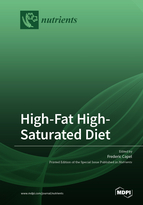High-Fat High-Saturated Diet
A special issue of Nutrients (ISSN 2072-6643). This special issue belongs to the section "Lipids".
Deadline for manuscript submissions: closed (31 October 2020) | Viewed by 52927
Special Issue Editor
Interests: omega 3 fatty acids; muscle; adipose tissue; lipotoxicity; metabolic syndrome
Special Issues, Collections and Topics in MDPI journals
Special Issue Information
Dear Colleagues,
Dietary fat quality is a major determinant of several physiological, biochemical and molecular processes in the body and tissues. As a source of energy, lipids are mainly stored in fat cells and within lipid droplets (LD) in oxidative and steroidogenic tissues, but significant amounts are also found in cell membranes where their structural role is crucial for membrane protein functions and the control of cellular functions. Differential effects have been identified between different types of Fatty Acids (FA) on inflammatory and metabolic diseases during obesity or in response to physical exercise and chronic diseases. All the tissues and organs of the body are concerned. The most recent dietary guidelines advise that lipids should represent 35% of the daily energy intake in order to prevent deleterious effects of high glycaemic index carbohydrates and deficiency in essential fatty acids. Hence, the prevalence of obesity could rise dramatically despite a fall in total fat intake. Advice is more focused on the improvement of the quality of fat than on the reduction of total fat intake. Dietary fat sources provide a mixture of saturated FA (SFA), monounsaturated FA (MUFA) and polyunsaturated FA (PUFA). Although some controversies exist, most institutional dietary guidelines claim that the consumption of SFA should be limited to the expense of MUFA and PUFA as a nutritional strategy for the prevention of chronic diseases and the lipotoxic effect of some lipid derivates. The role of dietary SFA and MUFA in cardiometabolic risk remains controversial in the scientific community. This field still needs interventional and fundamental investigations to identify key lipid mediators involved in biological abnormalities and the underlying mechanisms. You are invited to submit proposals for manuscripts that bring new elements into this topic.
Dr. Frederic Capel
Guest Editor
Manuscript Submission Information
Manuscripts should be submitted online at www.mdpi.com by registering and logging in to this website. Once you are registered, click here to go to the submission form. Manuscripts can be submitted until the deadline. All submissions that pass pre-check are peer-reviewed. Accepted papers will be published continuously in the journal (as soon as accepted) and will be listed together on the special issue website. Research articles, review articles as well as short communications are invited. For planned papers, a title and short abstract (about 100 words) can be sent to the Editorial Office for announcement on this website.
Submitted manuscripts should not have been published previously, nor be under consideration for publication elsewhere (except conference proceedings papers). All manuscripts are thoroughly refereed through a single-blind peer-review process. A guide for authors and other relevant information for submission of manuscripts is available on the Instructions for Authors page. Nutrients is an international peer-reviewed open access semimonthly journal published by MDPI.
Please visit the Instructions for Authors page before submitting a manuscript. The Article Processing Charge (APC) for publication in this open access journal is 2900 CHF (Swiss Francs). Submitted papers should be well formatted and use good English. Authors may use MDPI's English editing service prior to publication or during author revisions.
Keywords
- Fatty acid
- metabolism
- high fat diet
- metabolism
- nutrition
- obesity
- metabolic syndrome
- lipotoxicity







